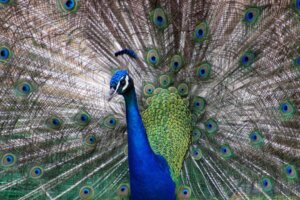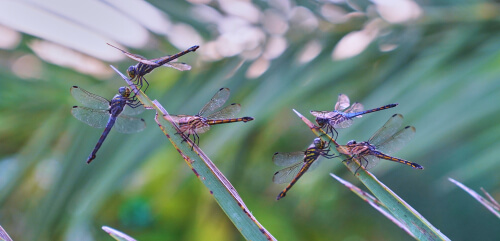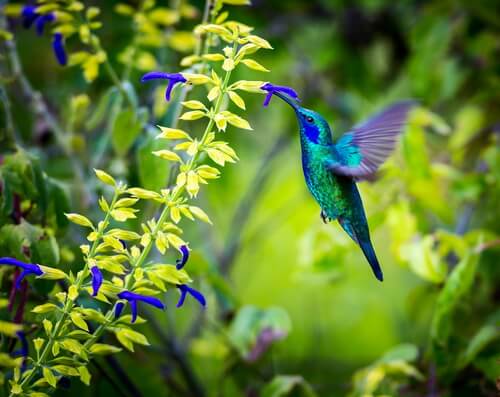Why Are Some Animals Iridescent?

Animals with iridescent colors have fascinated humans since time immemorial. They’re metal-like, changeable and, above all, beautiful. But why are some animals iridescent? And do animals perceive it as we do?
Many scientists have asked themselves these questions, because something as striking as iridescence doesn’t seem very adaptive in terms of survival. Fortunately, there are already some answers that you can find in this article, because nature has a reason for everything. Don’t miss it.
What is iridescence?
Iridiscence is a visual phenomenon in which a different color is perceived on a surface depending on its angle. Depending on the angle from which it’s observed, the reflected color is different, and makes the animal look different when it moves.
You can observe iridescence in the feathers of a peacock or a hummingbird. It’s also present in some insects, such as the royal beetle or dragonflies. Whatever the surface, the effect is striking.

The paradox of iridescence in animals
It’s precisely the striking nature of iridescence that intrigues researchers. Isn’t it easier for a bird to find an iridescent beetle than one that camouflages itself on a plant leaf? By logic, these changing colors should be the undoing of some animals, yet their population isn’t observed to diminish because of it.
It’s often compared to aposematism, i.e., a bright, conspicuous coloration that warns predators of a possible poison or threat. However, there’s a premise among those who study animal communication, which is that signals must be clear in order for the observing animal to understand. Is the signal from a surface that casts changing colors, as in the case of iridescence, considered clear?
As research progressed, it was found (once again) that it can’t be investigated from an anthropocentric point of view. In the following section, we’ll tell you why.
Why are some animals iridescent?
As we said, the most important rule of communication is that the message must be clear in order to be understood. As iridescent colors change continuously (as it’s rare for both the observer and the animal to be completely still), how do they manage to send a message based on their coloration?
The answer, of course, lay in the study of the animals’ perception. What for us is a moving rainbow, for iridescent animals is a tool. Let’s look in detail at the two main uses it has.
Sexual selection
When bright colors aren’t used to warn of the danger of being preyed upon, they’re often used to find a mate. Birds are the best example of this, because, in many species, the most colorful, large, and skillful displaying male is usually the one that finds a mate first (or a greater number of them).
Iridescence plays a fundamental role here. In addition, it must be taken into account that animals aren’t usually passive “flirts”, i.e., in addition to their striking appearance, they also engage in behavior that takes advantage of these characteristics. For example, the peacock knows that it has to open its tail and direct it towards the female to convince her to mate with it.
Another interesting example is Anna’s hummingbird (Calypte anna), which controls its flight so that its iridescent feathers only reflect a deep pink in front of the female.
The defensive potential of iridescent animals

Apparently, iridescence can also serve a defensive function against predators. Like the aposematism mentioned above, the shiny effect is also capable of deterring predators and sending a clear message.
In particular, one study found that, compared to dull-colored beetles and brightly colored beetles, birds were less likely to eat the iridescent ones.
On the other hand, another study verified that high levels of stress in the lizard Ctenophorus decresii produced changes in its coloration. When they felt in danger, the skin around their throat became lighter and the iridescence of their scales increased. This shows that the animal is sending a message through the coloration of the skin, making it more conspicuous as a warning.
As you can see, iridescent animals are further proof that nature doesn’t always comply with the laws we humans attribute to it. Camouflage is often thought to be the most effective technique for survival, but the truth is that eye-catching colors can also be effective when it comes to defense and finding a mate. What else is left to discover?!
All cited sources were thoroughly reviewed by our team to ensure their quality, reliability, currency, and validity. The bibliography of this article was considered reliable and of academic or scientific accuracy.
- BirdLife International. 2021. Calypte anna. The IUCN Red List of Threatened Species 2021: e.T22688199A186913595. https://dx.doi.org/10.2305/IUCN.UK.2021-3.RLTS.T22688199A186913595.en. Accessed on 25 August 2022.
- Kjernsmo, K., Lim, A. M., Middleton, R., Hall, J. R., Costello, L. M., Whitney, H. M., … & Cuthill, I. C. (2022). Beetle iridescence induces an avoidance response in naïve avian predators. Animal Behaviour, 188, 45-50.
- Doucet, S. M., & Meadows, M. G. (2009). Iridescence: a functional perspective. Journal of The Royal Society Interface, 6(suppl_2), S115-S132.
- Stuart-Fox, D., Ospina-Rozo, L., Ng, L., & Franklin, A. M. (2021). The paradox of iridescent signals. Trends in Ecology & Evolution, 36(3), 187-195.
This text is provided for informational purposes only and does not replace consultation with a professional. If in doubt, consult your specialist.